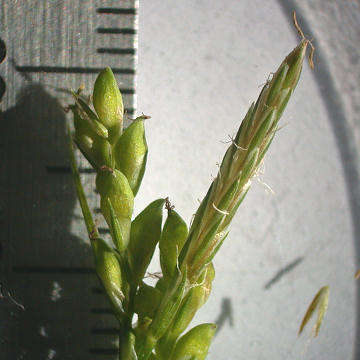

Carex leptonervia - (image 1 of 6)
Taxonomy
Family: Cyperaceae
Section Laxiflorae
Habitat
Wet-mesic swamps, moist woods.
Associates
Distribution
Newfoundland to northeast MN, south to NJ, PA, IN, and WI, and south in mountains to NC and TN.
Morphology
Stems tufted, to 60 cm; basal sheaths brown; leaves to 1 cm wide; upper bract-sheaths minutely serrulate on the angles; terminal spike staminate, to 1.6 cm, sessile or short-pedunculate, sometimes slightly surpassing the uppermost pistillate spike, often exceeded by the uppermost bract; pistillate spikes 2-4, 1-2 cm, sessile or short-peduncled, none basal; second bract often exceeding all the spikes; pistillate scales usually short-awned or apiculate; perigynia 5-14, to 4.1 mm, crowded, 2-ribbed but otherwise nerveless or obscurely nerved, obovoid and obtusely trigonous, contracted abruptly to a short, entire beak; achene obtusely trigonous; stigmas 3.
Notes
Fruiting May to June
Wetland indicator: FAC
Section Laxiflorae includes the wood sedges and is a monophyletic group. Three characteristics separate this species from the others: 1) Perigynia not sharply trigonous; 2) none of the spikes basal; and 3) Perigynia with 2 prominent ribs with the remaining 8-18 obscure or absent. The evident finer nerves on the perigynia of other species may not be readily apparent in fresh specimens though they become more apparent upon drying.
References
Bryson, C. T. 1980. A Revision of the North American Carex Sect. Laxiflorae (Cyperaceae). Ph.D. dissertation. Mississippi State University
Gleason, Henry A. and A. Cronquist. 1991. Manual of Vascular Plants of
Northeastern United States and Adjacent Canada. Second Ed.
The New York Botanical Garden. Bronx, NY
Swink, F. and G. Wilhelm. 1994. Plants of the Chicago Region.
Indiana Academy of Science. The Morton Arboretum. Lisle, Illinois.
|
© Michael Hough 2010 |